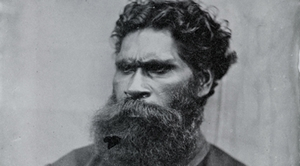Barak Campus — Years 10 to 12
The Year 10-12 Campus is named after the Wurundjeri tribal leader, William Barak. In preparing students for their tertiary and career pathways, campus life is also dedicated to empowering students to explore opportunities in the areas of faith development, social justice initiatives and community engagement that include:
- Academic Programs: Skills for Work, VCE including VCE-Vocational Major, VET and ASBA apprenticeships
- Faith Development Programs: Masses, liturgies, year level Retreats, Catherine's Cafe community van, Ozanam House, Regina Coeli
- Student Leadership: Prefects, Pastoral Ministry, Peer Support and mentoring
- Social Justice: Seeds of Justice, Catherine's Cafe community van, Yellow Ribbon Ambassadors, Regina Coeli, Ozanam House
- Cocurricular: Performing Arts, Sport, Year Level Socials, Debating and Public Speaking.
William Barak

Born in 1824, William Barak was a member of the Wurundjeri clan of the Woiworung people in the area of Melbourne now known as Croydon. Originally known as Beruk Barak he adopted the name William after joining the Native Police as a 19-year-old. As a young boy in 1835, he witnessed his father Bebejan, his uncle Billibellary, and other tribal Elders sign John Batman’s Treaty which was to have grave consequences for his people. His father was the NAARM (Melbourne) region’s most senior Elder.
From the late 1870s he became a leading spokesman for his people and was an important negotiator between his people and the government. He was a prominent figure in the struggle for Indigenous rights and justice. He suggested to the Victorian government that they set up self-governing Aboriginal communities. "Give us this ground and let us manage here ourselves ... and no one over us," he said. With his cousin Simon Wonga, Barak worked to establish and protect the self-sufficient Aboriginal farming community Coranderrk, near Healesville, and when his cousin died in 1875 he succeeded him as clan leader.
Despite many negotiations and walks to Parliament to plead his case, the government took over half of the Coranderrk land in 1893 and by 1923 the people who were still living there were sent to Lake Tyers. Barak was held in high regard as an artist and many of his works are held in Victoria’s cultural institutions. His art showed the complexity and importance of his peoples' cultural and spiritual life. Barak also combined traditional Indigenous materials with European techniques and paints.
At Coranderrk, where Indigenous ceremonies were banned, Barak used his paintings to teach and lead his people, passing on Aboriginal history and customs. Says Joy Murphy-Wandin: "Perhaps Barak knew that people would be writing stories about his life. Maybe he felt the need to tell his own story in his own way. These beautiful images reiterate and confirm the importance of identity and the central place of ceremony in Aboriginal society. These images should not be ignored. They are embedded with respect and integrity and represent the stories of the oldest living culture in the world."
Campus Leadership 2023
The Barak Campus is led by a Campus Director who is committed to coordinating the daily life and learning experience of students from Years 10-12.
Barak Campus Director: Mr Kamahl Russell
Each of our Year Levels have two Year Level Leaders who lead the homeroom teacher team in caring for the academic progress and pastoral care of students. In 2022 they are:
Year 10: Mr Greg Hysted and Mr Denver Carron
Year 11: Mrs Marie Prusac and Mr Tom Warren
Year 12: Mr Andrew Leaumont and Mrs Alison Schlueter
Students also have their learning program tracked and monitored by a Learning Advisor to ensure maximum progress in their academic program:
Barak Campus Learning Advisor: Ms Krystle Samios


